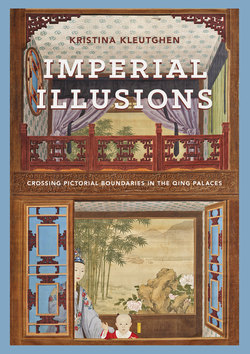Читать книгу Imperial Illusions - Kristina Kleutghen - Страница 18
На сайте Литреса книга снята с продажи.
Оглавлениеformats of scrolls, albums, fans, and screens. Traditionally, a portable painting was physically present and identifiable because its format, viewing customs, and storage practices all demanded that viewers engage it with the knowledge that it was a painting well before actually seeing brush traces on paper or silk. This knowledge created a sense of anticipation that encoded all ensuing thoughts and actions with the meaning “viewing a painting” and physically connected the viewer with the material object identified as a painting prior to seeing the work. Furthermore, by the Qing dynasty the vocabulary that had developed specifically for “looking at a painting” (kan hua) or “reading a painting” (du hua) implied an acquired skill particular to the learned elite gentleman capable of truly contemplating or scrutinizing (guan) a work: “scholars contemplate, while peasants (along with women, children, and eunuchs) just look.”14 Before the elite male implicitly understood to be the appropriate viewer even physically saw a painting, therefore, he was already firmly situated within a complex preconditioned visuality.
In contrast, the emperor encountered a scenic illusion without performing any of the physical movements or thought processes that typically preceded “viewing a painting,” such as unrolling a scroll or opening an album, and initially received no visible contextual or material clues to suggest that the view was a painting. Scenic illusions typically did not receive seals or inscriptions (traditional marks of authorship, ownership, appreciation, and pictorial surface), which eliminated another key cultural process that instantiated paintings as such. In short, the combined aesthetic and kinesthetic experience that prepared the eighteenth-century Chinese elite male viewer to “view a painting” was short- circuited: he simply entered a room and, without any preparation or expectations, faced a scene that appeared real. Discovering that the view was merely a realistic painting then forced him to question his perceptions and his sophistication: historically, realistic and illusionistic painting was generally considered a lesser art form suitable for the undereducated populace who could be deceived by such things, while the educated gentleman was not fooled by such superficial visual trickery. For the sake of the illusionistic effect, therefore, scenic illusion paintings initially sacrificed the entire established set of criteria and viewing practices that historically defined Chinese paintings as art, and thus questioned the trustworthiness of the viewer’s senses.
This did not mean that scenic illusions were disconnected from works that were unquestionably defined as paintings. Although the architectural illusion is original, the motif in the center of the Spring’s Peaceful Message scenic illusion is related to an earlier work, a small hanging scroll with the same title (figure I.3). This scroll, produced decades earlier by the Italian Jesuit lay brother painter Giuseppe Castiglione (Lang Shining, 1688–1766), depicts the favor that the Yongzheng emperor bestowed on Qianlong while the latter was still a prince. As a young man with demonstrated intellectual and physical abilities, Qianlong enjoyed a special relationship with his grandfather, the Kangxi emperor (r. 1661–1722), which is thought to have influenced Yongzheng’s decision to officially (but secretly) declare this favorite son the future heir when he ascended to the throne in 1723.
